Contemplating emptiness
I have been going through a phase in my life where my engagement with “the affairs of men” has been extreme. Too many projects. Too many commitments. Too many things and people to show up for. As I have been sitting with the resulting exhaustion, I am realizing two things. Not just in my mind, but in a very felt way.
First, I am realizing that I simply love this whirling life! I enjoy being swept up in this ecstatic dance of life. The abundance. The manifestation. The ten thousand things. I want to feel like the Sufi dervish, skirts billowing, one with the Dance of Life.
This is where comes my second realization. I cannot sustain this centrifugal energy - this outward-going life force - if I cannot simultaneously hold a steady center. A center from where all movement emanates.
I am realizing that at least a part of my problem has been that I have been trying to find this center through embodiment - through grounding, through yoga. I was imagining the still point I was seeking, my axis mundi, as solid and firm. And don’t get me wrong, these grounding practices have helped - immensely. They have literally kept me from completely spinning out!
However, I am realizing that I forgot a very important lesson; that the very center of the circle is actually not solid - it is in fact hollow. Empty. All existence emanates from this emptiness. So, I am going back more deeply now into the contemplation of emptiness, and finding the Tao Te Ching coming to my aid.
I am sitting specifically with the Verse 11 of Tao Te Ching that speaks about wu, emptiness or nothingness, which allows us to practice wu wei, the practice of doing-without-doing. The statement goes something like, “I do nothing, and everything gets done.”
The Chinese term wu wei is a two-character composite with the first character (無) meaning ‘not’ (in the sense of non-existence or non-presence) and the second (為) meaning ‘do’ or ‘act’ (Source: New World Encyclopedia)
Below are several translations of verse 11 of Tao Te Ching, for your contemplation.
Signboard "Wuwei" in Emperors palace, Beijing (Source: Wikimedia)
Wu is nothingness, emptiness, non-existence
Thirty spokes of a wheel all join at a common hub
yet only the hole at the center
allows the wheel to spin
Clay is molded to form a cup
yet only the Space Within
allows the cup to hold water
Walls are joined to make a room
yet only by cutting out a door and a window
can one enter the room and live there
Thus, when a thing has existence alone
it is mere dead-weight
Only when it has wu, does it have life
(Translation by Jonathan Star)
Storage Vessel (Kame), Japan, Muromachi period (1392-1573) (Source: Wikimedia)
We join spokes together in a wheel,
but it is the center hole
that makes the wagon move.
We shape clay into a pot,
but it is the emptiness inside
that holds whatever we want.
We hammer wood for a house,
but it is the inner space
that makes it livable.
We work with being,
but non-being is what we use.
(Translation by Stephen Mitchell)
Postcard from Chinkairo, a Japanese inn in Smimonoseki (Source: Wikimedia)
The uses of not
Thirty spokes
meet in the hub.
Where the wheel isn’t
is where it’s useful.
Hollowed out,
clay makes a pot.
Where the pot’s not
is where it’s useful.
Cut doors and windows
to make a room.
Where the room isn’t,
there’s room for you.
So the profit in what is
is in the use of what isn’t.
(Translation by Ursula Le Guin)
Detail of The Spinning Wheel, by Chinese artist Wang Juzheng, Northern Song Dynasty (c. 1270). (Source: Wikimedia)
Thirty spokes converge on a hub
but it's the emptiness that makes a wheel work
pots are fashioned from clay
but it's the hollow that make a pot work
windows and doors are carved for a house
but it's the spaces that make a house work
existence makes something useful
but nonexistence makes it work
(Translation by Red Pine)



